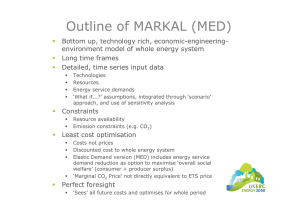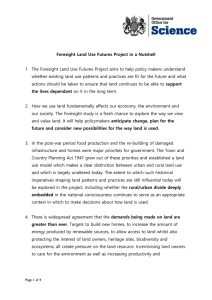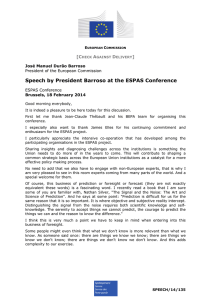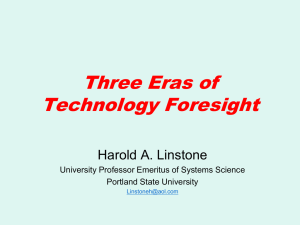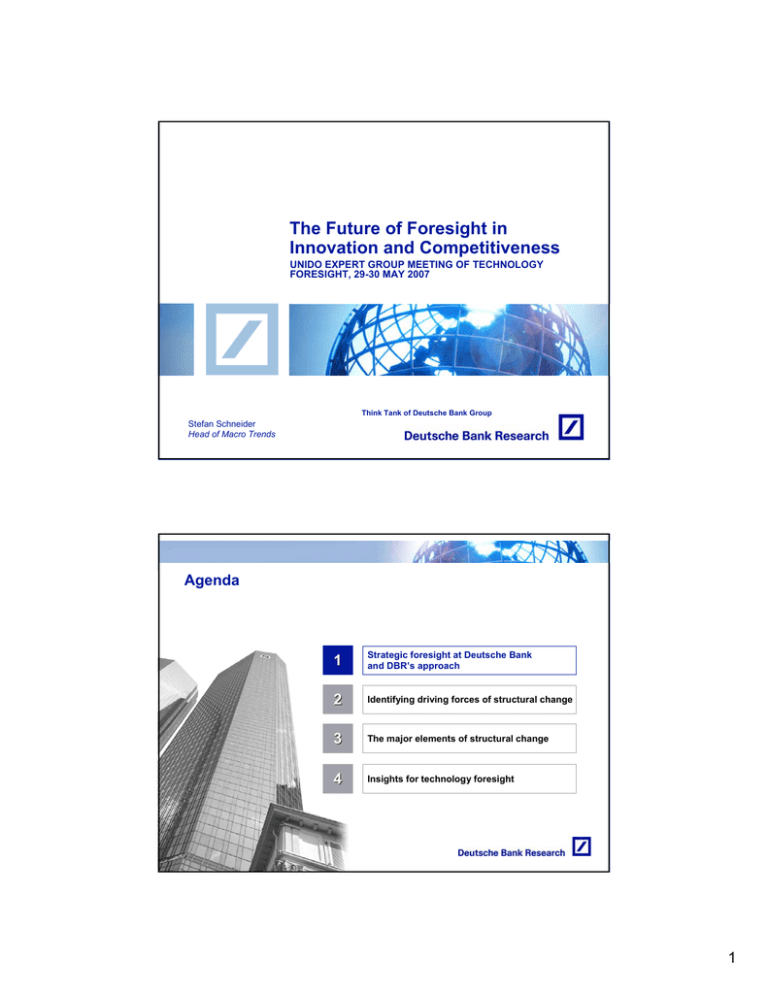
The Future of Foresight in
Innovation and Competitiveness
UNIDO EXPERT GROUP MEETING OF TECHNOLOGY
FORESIGHT, 29-30 MAY 2007
Think Tank of Deutsche Bank Group
Stefan Schneider
Head of Macro Trends
Agenda
1
Strategic foresight at Deutsche Bank
and DBR’s approach
2
Identifying driving forces of structural change
3
The major elements of structural change
4
Insights for technology foresight
Stefan Schneider, May 29-30, 2007 · date · page 2
1
1
Strategic foresight at Deutsche Bank and DBR’s approach
Strategic foresight at Deutsche Bank
DBR’s strategic foresight activities are aimed at
identifying relevant future trends and incorporating them into the strategic and
decision-making processes of Deutsche Bank’s management
providing input for economic and socio-political discussions
DBR’s strategic foresight activities are characterised by…
… long-term future prospects
… a wide spectrum of methods
… interdisciplinary teams.
Stefan Schneider, May 29-30, 2007 · date · page 3
1
Strategic foresight at Deutsche Bank and DBR’s approach
A wide spectrum of methods
Direct forecast
Alternative futures
Social analyses
Scenario
analysis
Qualitative
analysis
Trend projection
Quantitative
analysis
Short-term
GDP forecasts
System
dynamics
GDP risk model
Regression
models
Stefan Schneider, May 29-30, 2007 · date · page 4
2
Agenda
1
Strategic foresight at Deutsche Bank
and DBR’s approach
2
Identifying driving forces of structural change
3
The major elements of structural change
4
Insights for technology foresight
Stefan Schneider, May 29-30, 2007 · date · page 5
2
Identifying driving forces of structural change
Case study:
Germany 2020
Creating consistent
pictures of the future
Stefan Schneider, May 29-30, 2007 · date · page 6
3
2
Identifying driving forces of structural change
The broad scan matters
Building consistent pictures and deriving scenarios by reducing complexity
Aggregation step 2:
Scenario cross
Aggregation step 1:
Dynamics map
Base:
Parameters/
trends
Scenario
Core dynamic
Dynamic
Trend dynamic
Parameter
Trend
Stefan Schneider, May 29-30, 2007 · date · page 7
Agenda
1
Strategic foresight at Deutsche Bank
and DBR’s approach
2
Identifying driving forces of structural change
3
The major elements of structural change
4
Insights for technology foresight
Stefan Schneider, May 29-30, 2007 · date · page 8
4
3
The major elements of structural change
Dynamics of structural change (trend-like)
Labour migration increases
Growing urbanisation
Micro and nano technology
Biotechnology
More flexible career paths
Conquest of
smallest structures
Opening of
work and
society
Women gain more
importance in employment
Economisation of the healthcare sector
Convergence of R&D fields
Medical care
Body tech
Virtualisation of
organisational and
market processes
Rising interactivity in
e-disintermediation
media consumption
Processvirtualisation
in netProcessor / memory works
New affinities
More flexible
time management
Differentiation in mobility
Grid computing
Broadband
infrastructures
Changed
lifestyles,
family structures
Integration of networks
and databases
Ambient intelligence
Sport a
growth market
Health / body
consciousness
Food quality
Always on
Spending on
communication
capacity
Ageing populations
Healthcare sector grows
Lengthening
Life span
Fragmentation
in societies
More religiosity
Electronic networks more
pervasive and better
Gulf in skill levels
Polarisation children
vs. no children
Diverging incomes
Pluralisation of values
China and India grow
hugely in importance
Environmental
Environmental
awareness
protection
Climate change
Environmental services
Growing strength of emerging markets
Growing international
economic imbalance
Emerging markets gain
increasing importance
Growing scarcity of
natural resources
Shortage of high-quality
water
More international
coordination
Markets deregulated at the national level
Presence of foreign service providers
Global networking in
business and politics
Services across borders
Concentration of companies
into global industries
Global institutions
gain more influence
Depletion
of production-critical
raw materials
More regenerative
energies
Energy diversification
From farmer to energy supplier
Depletion of fossil fuels
Transnational companies
gain increasing importance
Stronger differentiation of
international division of labour
Stefan Schneider, May 29-30, 2007 · date · page 9
3
The major elements of structural change
Dynamics of structural change (non-trend-like)
Federalism
reform
Size and growing integration of EU
Problems in funding social security systems
Fiscal room for manoeuvre
Int‘l rule enforcement
Efficient state-citizen cooperation
New
political understanding
Shaping the
Provision and efficiency of
politico-legal framework
social services
Social commitment
New financing options
Unemployment
Change in business culture
and value creation patterns
Willingness
to take risks
Change in
financial services sector
Creativity culture
in organisations
Openness of corporate processes
Communities of practice
Sectoral boundaries
fade
Willingness to invest
Standardised products / processes
Financial insecurity
Subjective well-being
Differentiation in
consumption
International web-based sectors
Start-up activity
Higher skills / more
training
Technology affinity / growing use
of technology in everyday life
More trade in intellectual property
Valuation of intangible assets
R & D competition
Economisation of learning
Knowledge-intensive services
Media content gains in importance
Level / efficiency of R&D spending
Shortage of highly skilled young people
New culture in basic research
Democratisation of the Internet
Validation of information,
Development of
knowledge and identities
the knowledge base Concentration on information
geogr. Ballung Hochqualifizierter
Growing importance of standards
Structuring of intellectual property rights
Diverging consumption patterns
Greater consumption diversity
Corporate networking
Rising education
spending / efficiency
Tapping the
social potential
Entitlement mentality
Integration of the financial markets
Focus on core competences
More system
products
Upward mobility
Confidence in the future
Performance-driven
about citizens
Automation 2.0
New forms of contact /
networking between individuals
Higher-quality products
Usability of services,
Supply-side specialistation /
goods
niche markets
Consumer sovereignty
Hybrid customers
Criminalisation
International terrorism
Rise in / new forms of criminal activity
IT threats, data security
Accelerated knowledge generation
Stefan Schneider, May 29-30, 2007 · date · page 10
5
3
The major elements of structural change
DBR’s dynamics map
Opening of
work and
society
Conquest of
smallest structures
Shaping the politico-legal
framework
Tapping
the social potential
Change in business culture
and value creation patterns
Process
virtualisation
in networks
Lengthening
life span
Differentiation in
consumption
Development of
the knowledge base
Fragmentation
in
societies
Criminalisation
Growing scarcity of
natural resources
Growing strength of
emerging markets
Global networking in
business and politics
Dynamic (future development uncertain)
Core dynamic (future development uncertain)
Trend dynamic (future development predictable)
Stefan Schneider, May 29-30, 2007 · date · page 11
Agenda
1
Strategic foresight at Deutsche Bank
and DBR’s approach
2
Identifying driving forces of structural change
3
The major elements of structural change
4
Insights for technology foresight
Stefan Schneider, May 29-30, 2007 · date · page 12
6
4
Insights for technology foresight
Dynamics in perspective: Insights for technology
foresight
A three-fold framework:
1. New societal needs for technological solutions
(pulling technologies)
2. New structures and processes of innovation and technology creation
(pushing technologies)
3. New technologies needed for these new innovation and production processes
(pulling technologies).
Stefan Schneider, May 29-30, 2007 · date · page 13
4
Insights for technology foresight
New societal needs for technological solutions (I)
Opening of
work and
society
Conquest of
smallest structures
Shaping the politico-legal
framework
Tapping
the social
Assistance systems
to potential
increase mobility
Change in businessand
culture
cognitive abilitiesDifferentiation in
and value creation patterns
Process
virtualisation
in networks
Lengthening
life span
consumption
Increasing autonomy
and quality of life
Development of
home) Criminalisation
the knowledge(smart
base
Fragmentation
in
societies
Growing scarcity of
natural resources
Growing strength of
emerging markets
Global networking in
business and politics
Dynamic (future development uncertain)
Core dynamic (future development uncertain)
Trend dynamic (future development predictable)
Stefan Schneider, May 29-30, 2007 · date · page 14
7
4
Insights for technology foresight
New societal needs for technological solutions (I)
Opening of
work and
society
Conquest of
smallest structures
Shaping the politico-legal
framework
Tapping
the social potential
Lengthening
life span
Change in business
culture
Medical
and value creation patterns
devices to repair/
Differentiation in
replace worn-out organs,
consumption
joints, etc.
Process
virtualisation
in networks
Development of
the knowledge base
Fragmentation
in
societies
Criminalisation
Growing scarcity of
natural resources
Growing strength of
emerging markets
Global networking in
business and politics
Dynamic (future development uncertain)
Core dynamic (future development uncertain)
Trend dynamic (future development predictable)
Stefan Schneider, May 29-30, 2007 · date · page 15
4
Insights for technology foresight
New societal needs for technological solutions (III)
Opening of
work and
society
Conquest of
smallest structures
Process
virtualisation
in networks
Shaping the politico-legal
framework
Stronger need
to
communicate with
sovereign customers
Change inorganised
business culture
in virtual
and value creation patterns
communities
Tapping
the social potential
Increasing
wish among
Development of
individuals
tobase
interact
the knowledge
with peers
Lengthening
life span
Differentiation in
consumption
Fragmentation
in
societies
Criminalisation
Growing scarcity of
natural resources
Growing strength of
emerging markets
Global networking in
business and politics
Dynamic (future development uncertain)
Core dynamic (future development uncertain)
Trend dynamic (future development predictable)
Stefan Schneider, May 29-30, 2007 · date · page 16
8
4
Insights for technology foresight
New structures and processes of innovation and
technology creation
Opening of
work and
society
Conquest of
smallest structures
Shaping the politico-legal
framework
Tapping Project economyLengthening
the social potential(new players, more life span
funding, more efficient
IP markets)
open and
cooperative innovation
process
Fragmentation
Increased supply of
in
Criminalisation
societies
innovations
Change in business culture
and value creation patterns
Process
virtualisation
in networks
Differentiation in
More
consumption
Development of
the knowledge base
Growing scarcity of
natural resources
Growing strength of
emerging markets
Global networking in
business and politics
Dynamic (future development uncertain)
Core dynamic (future development uncertain)
Trend dynamic (future development predictable)
Stefan Schneider, May 29-30, 2007 · date · page 17
4
Insights for technology foresight
New technologies needed for these new innovation and
production processes
Opening of
work and
society
Conquest of
smallest structures
Shaping the politico-legal
framework
Tapping
the social potential
Collaborative
Change in business culture
and value creation patterns
Process
virtualisation
in networks
Development of
the knowledge base
Lengthening
life span
innovation
with teams in
different locations
Differentiation in
requires smarter
consumption
visualisation, intelligent
modelling and Fragmentation
in
Criminalisation simulation tools
societies
Growing scarcity of
natural resources
Growing strength of
emerging markets
Global networking in
business and politics
Dynamic (future development uncertain)
Core dynamic (future development uncertain)
Trend dynamic (future development predictable)
Stefan Schneider, May 29-30, 2007 · date · page 18
9
4
Insights for technology foresight
Summary
In order to use foresight to boost innovation and competitiveness
and help decision-makers…
a broadly based foresight process encompassing methodically societal,
political, economic and technological trends should be used,
complexity should be reduced by identifying parameters and trends and
aggregating those into dynamics,
aggregated dynamics should be chartered (depicted) in maps showing their
impacts, references, interdependences, allowing a constant verification of
dynamics and impact-schemes, making it easier to derive implications,
pure technology-oriented foresight should be amended to incorporate the
analysis of societies and markets for technology.
A three-fold framework can be applied which differentiates between
– new societal needs
– new structures and processes of innovation
– new technologies needed for these new innovation processes.
Stefan Schneider, May 29-30, 2007 · date · page 19
© Copyright 2007. Deutsche Bank AG, DB Research, D-60262 Frankfurt am Main, Germany. All rights reserved. When quoting please cite
“Deutsche Bank Research”.
The above information does not constitute the provision of investment, legal or tax advice. Any views expressed reflect the current views of the
author, which do not necessarily correspond to the opinions of Deutsche Bank AG or its affiliates. Opinions expressed may change without
notice. Opinions expressed may differ from views set out in other documents, including research, published by Deutsche Bank. The above
information is provided for informational purposes only and without any obligation, whether contractual or otherwise. No warranty or
representation is made as to the correctness, completeness and accuracy of the information given or the assessments made.
In Germany this information is approved and/or communicated by Deutsche Bank AG Frankfurt, authorised by Bundesanstalt für Finanzdienstleistungsaufsicht. In the United Kingdom this information is approved and/or communicated by Deutsche Bank AG London, a member of
the London Stock Exchange regulated by the Financial Services Authority for the conduct of investment business in the UK. This information is
distributed in Hong Kong by Deutsche Bank AG, Hong Kong Branch, in Korea by Deutsche Securities Korea Co. and in Singapore by Deutsche
Bank AG, Singapore Branch. In Japan this information is approved and/or distributed by Deutsche Securities Limited, Tokyo Branch. In
Australia, retail clients should obtain a copy of a Product Disclosure Statement (PDS) relating to any financial product referred to in this report
and consider the PDS before making any decision about whether to acquire the product.
Stefan Schneider, May 29-30, 2007 · date · page 20
10

